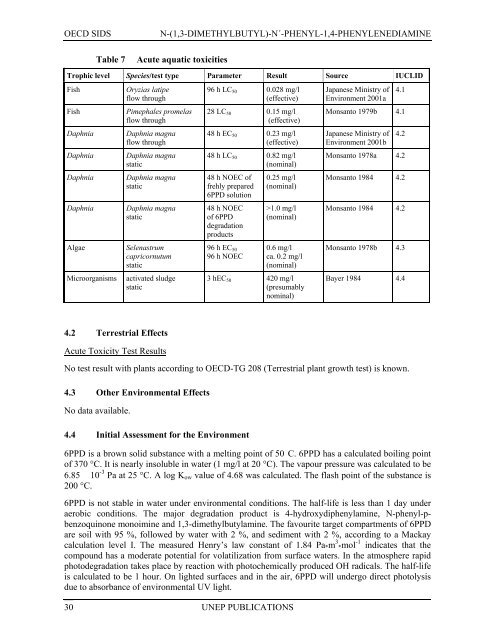N-(1,3-Dimethylbutyl)-N
N-(1,3-Dimethylbutyl)-N
N-(1,3-Dimethylbutyl)-N
You also want an ePaper? Increase the reach of your titles
YUMPU automatically turns print PDFs into web optimized ePapers that Google loves.
OECD SIDS<br />
Table 7<br />
N-(1,3-DIMETHYLBUTYL)-N´-PHENYL-1,4-PHENYLENEDIAMINE<br />
Acute aquatic toxicities<br />
Trophic level Species/test type Parameter Result Source IUCLID<br />
Fish<br />
Fish<br />
Daphnia<br />
Daphnia<br />
Daphnia<br />
Daphnia<br />
Algae<br />
Microorganisms<br />
Oryzias latipe<br />
flow through<br />
Pimephales promelas<br />
flow through<br />
Daphnia magna<br />
flow through<br />
Daphnia magna<br />
static<br />
Daphnia magna<br />
static<br />
Daphnia magna<br />
static<br />
Selenastrum<br />
capricornutum<br />
static<br />
activated sludge<br />
static<br />
96 h LC 50 0.028 mg/l<br />
(effective)<br />
28 LC 50 0.15 mg/l<br />
(effective)<br />
48 h EC 50 0.23 mg/l<br />
(effective)<br />
48 h LC 50 0.82 mg/l<br />
(nominal)<br />
48 h NOEC of<br />
frehly prepared<br />
6PPD solution<br />
48 h NOEC<br />
of 6PPD<br />
degradation<br />
products<br />
96 h EC 50<br />
96 h NOEC<br />
0.25 mg/l<br />
(nominal)<br />
>1.0 mg/l<br />
(nominal)<br />
0.6 mg/l<br />
ca. 0.2 mg/l<br />
(nominal)<br />
3 hEC 50 420 mg/l<br />
(presumably<br />
nominal)<br />
Japanese Ministry of<br />
Environment 2001a<br />
4.1<br />
Monsanto 1979b 4.1<br />
Japanese Ministry of<br />
Environment 2001b<br />
4.2<br />
Monsanto 1978a 4.2<br />
Monsanto 1984 4.2<br />
Monsanto 1984 4.2<br />
Monsanto 1978b 4.3<br />
Bayer 1984 4.4<br />
4.2 Terrestrial Effects<br />
Acute Toxicity Test Results<br />
No test result with plants according to OECD-TG 208 (Terrestrial plant growth test) is known.<br />
4.3 Other Environmental Effects<br />
No data available.<br />
4.4 Initial Assessment for the Environment<br />
6PPD is a brown solid substance with a melting point of 50C. 6PPD has a calculated boiling point<br />
of 370 °C. It is nearly insoluble in water (1 mg/l at 20 °C). The vapour pressure was calculated to be<br />
6.85 10 -3 Pa at 25 °C. A log K ow value of 4.68 was calculated. The flash point of the substance is<br />
200 °C.<br />
6PPD is not stable in water under environmental conditions. The half-life is less than 1 day under<br />
aerobic conditions. The major degradation product is 4-hydroxydiphenylamine, N-phenyl-pbenzoquinone<br />
monoimine and 1,3-dimethylbutylamine. The favourite target compartments of 6PPD<br />
are soil with 95 %, followed by water with 2 %, and sediment with 2 %, according to a Mackay<br />
calculation level I. The measured Henry’s law constant of 1.84 Pa * m 3 *mol -1 indicates that the<br />
compound has a moderate potential for volatilization from surface waters. In the atmosphere rapid<br />
photodegradation takes place by reaction with photochemically produced OH radicals. The half-life<br />
is calculated to be 1 hour. On lighted surfaces and in the air, 6PPD will undergo direct photolysis<br />
due to absorbance of environmental UV light.<br />
30<br />
UNEP PUBLICATIONS
















